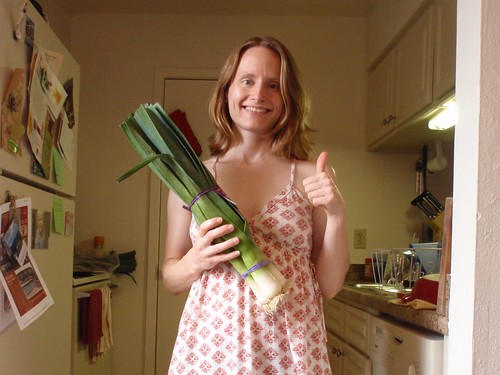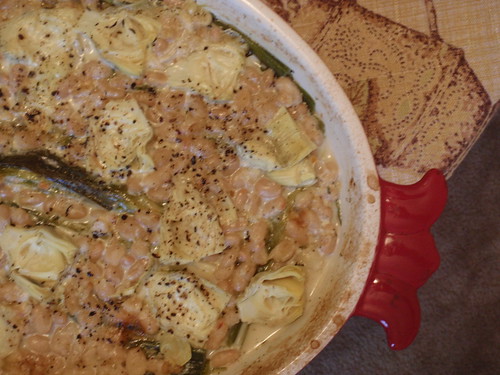I’m feeling like the Goldilocks of braised leek recipes, but I had a really good feeling about the latest one I tried.
This second attempt at making braised leeks came to me in the mailbox, in the form of EatingWell’s April 2011 issue. Their recipe calls for chicken, but after studying the recipe, I thought I could swap out the chicken for white beans (a classic Rose-Anne maneuver, if there ever was one, when vegetarianizing recipes). The thought of white beans reminded me of this recipe, and I decided that artichokes would also be delicious, in addition to the beans, so my version of braised leeks was slated to become a dreamy vegetarian main course.
I tried to learn my lesson from last time; this time I was determined not to let the leeks burn. The recipe called for braising the leeks, uncovered, in stock at 425 degrees F, but this made me a little nervous. I took the liberty of keeping them covered for 30 out of 40 minutes of braising time, then uncovering them for the rest of the cooking. At the 40-minute mark, the additions get tucked in with the leeks—white beans and halved artichoke hearts, in my case. One of the nice things about using canned beans here instead of chicken is that there is almost zero prep work: open can, dump out beans, rinse, and add to leeks. In contrast, the chicken recipe calls for browning the meat and cooking it in a skillet first, then adding the pre-cooked chicken to the leeks.
Things looked good at the 40-minute mark: the fork-tender leeks were still bathed in vegetable broth and nothing had burned. I added the beans and artichoke hearts, dotting the hearts around like decorative buttons. Before tucking the leeks back in the oven, I whisked some salt into half a cup of heavy cream and poured it over everything. The final touch was a judicious grinding of black pepper, and back into the oven the dish went.
For the final 15 minutes, I let everything cook uncovered, reasoning that the leeks were now protected from burning by everything that I’d put on top of them. At 15 minutes, I checked on things and found that the cream had merged with the stock to make a decadent but soupy sauce. Back into the oven. But by this time, I was getting hungry and impatient for dinner—this dish calls for about an hour of oven time, so it’s not one you can whip up and expect to eat 20 minutes later—so even though 5 minutes didn’t do much to dry up the soup, I took it out and dinner was served.
What a nice way to break in my new gratin dish! (I went with the red one, in case you couldn’t tell.) Flavorwise, this dish pushed all the right buttons: the delicate garden flavor of the leeks permeated the dish, which was wonderfully savory and balanced. The artichokes were a delicious addition, as they go so well with cream and other vegetal flavors. Texturewise, this dish is so close to being a dreamy recipe, but there are two problems. One, which you’ve probably already figured out, is that it’s too soupy! I wanted more of a creamy, silky sauce rather than a broth that runs all over my plate and soaks everything in its wake. The second problem is that I was a little too generous with my leek-chopping. I think for braised leeks, it’s better include only the most tender parts of the leek: the white and palest of green parts. The darker green parts are a little too chewy to be enjoyed in this dish, though they work fine in soup.
Because my braised leek project is clearly a work in progress, let’s consider the recipe below my notes on the experiment. I’m going to write the recipe as I followed it, and then below the recipe I’ll provide my suggestions for next time because dammit, there is going to be a next time! Braised leeks, soon I will make you just right for a showy vegetarian main course, one that I can serve to my friends without apology.
But for now, here’s a recipe, with my apologies.
Creamy Braised Leeks with White Beans and Artichokes
Adapted from this recipe in EatingWell
Serves 4 as a main course
Add a French baguette and a salad, and you’ve got a homey dinner you can share with friends. Oh, and I’d throw in a bottle of wine too, if I could get my hands on one. In my mind, dinner guests are an excuse to drink wine. (Don’t tell my friends—they’ll think I’m using them.)
4 large leeks
6 cloves garlic, peeled
1/2 tsp. dried thyme
2 cups vegetable stock
About 1 tbsp. extra-virgin olive oil
1 15-oz. can white beans, drained and rinsed
1 15-oz. can artichoke hearts, rough parts trimmed away and hearts sliced in half
1/2 cup heavy cream
1/2 tsp. salt
Freshly ground black pepper, to taste
1) Preheat the oven to 425 degrees F.
2) Prep the leeks. Trim away a few inches of the top, then slice off the root. Rinse the leeks by fanning the layers with your fingers to wash away any dirt that’s trapped in between them. Lay the leeks in a large baking dish. I used a 3-quart gratin dish; the original recipe called for a 9x13-inch dish.
3) Nestle the garlic cloves among the leeks. Sprinkle the thyme on top. Pour the vegetable stock over everything. Drizzle the olive oil over the leeks, especially any pieces that aren’t submerged in stock. Cover the dish with a piece of foil, and tuck it in the oven for 30 minutes. Remove the foil and bake for another 10 minutes.
4) Meanwhile, prep the white beans and artichokes as described above. After the leeks have braised for 40 minutes, remove the baking dish from the oven. Scatter the white beans over the leeks, then dot the artichoke hearts among the leeks and beans. Whisk the salt into the cream (it might not all dissolve—it’s okay), then pour the salted cream over everything. Grind a generous amount of pepper over the whole thing, then tuck it back into the oven for 20 minutes, or a bit longer if the sauce looks soupy.
5) Bring the dish to the table and serve. Serving braised leeks is a little awkward; I used my tongs to pull out the leeks, then I used a ladle to spoon the creamy sauce, white beans, and artichokes over the leeks.
Notes for the next time:
I really love the creamy element in this dish, but when eating the leftovers for lunch today, I realized that it’s almost too creamy for my taste. Next time, I think I’m going to make a substantial change by cutting the cream in half. The other major change is that I’m going to borrow a note from the first time I tried to make braised leeks by adding some wine to the braising liquid. I’ve listed these suggestions below to help myself remember. (Wait, what were we talking about? I forgot.)
Step 2: Trim the leeks, but keep only the white and pale green parts. Save the darker green parts for soup or another preparation that will cook them into submission.
Step 3: I’m still concerned about too much of the braising liquid cooking off too fast, so next time, I’d like to try the 40-minute step by covering the dish for the first 20 minutes, then uncovering for 20.
Step 4: Instead of 1/2 cup cream, I want to try 1/4 cup cream and 2 tbsp. dry white wine. I could even see 1/4 cup wine being delicious, but I’d start with 2 tbsp. first.



6 comments:
that does look pretty amazingly creamy!! love that red salad you posted recently too :) hope lab meeting went well!
Indeed! I love me some heavy cream. Did you try the red salad?
Lab meeting went well, I think. Nobody stood up and pointed at my data, saying, "THAT'S A LIE!" And that's good enough for me ;-)
This is a great recipe. I can't imagine it with chicken. This way the leeks are the centerpiece instead of the back-up to the chicken. I used white wine and it was great (although it's impossible to compare it to the non-wine method since I've only tried it once). I also didn't measure anything, but it turned out great regardless.
That is wonderful to hear, Daine! Since you didn't measure anything, I won't ask any specific questions, but I'm very encouraged to hear that it worked well for you. I suppose, though, that if I hadn't measured things, maybe I wouldn't have added so much cream in the first place! :-)
Happy cooking to you.
Just made this for the second time, and I think it turned out even better the second time around. I used too much stock so I kept turning the leeks and letting the stock cook off before adding the rest of the ingredients. The leeks ended up baking for about an hour before I added the beans and artichokes and were a lovely brown on all sides. I think I'll add more artichokes next time. I also cut back on the cream somewhat which made the whole dish slightly less heavy (we finished all of it this time), but I think I liked the texture of the sauce more when I put more in.
Anyway, great base for a recipe. Thanks for sharing!
Daine, you are on a roll! I bet those caramelized leeks were really delicious--that's a great idea. And I like the idea of less cream and more artichokes. The cream is really tasty, but it's so rich that it can be hard to eat the leeks as an entree! But I do think that a little cream can go a long way in cooking, so experimenting with the proportions is a good way to figure out how to get the most out of rich ingredients.
Thanks for your comments! I will have to try *your* version of braised leeks :-)
Post a Comment